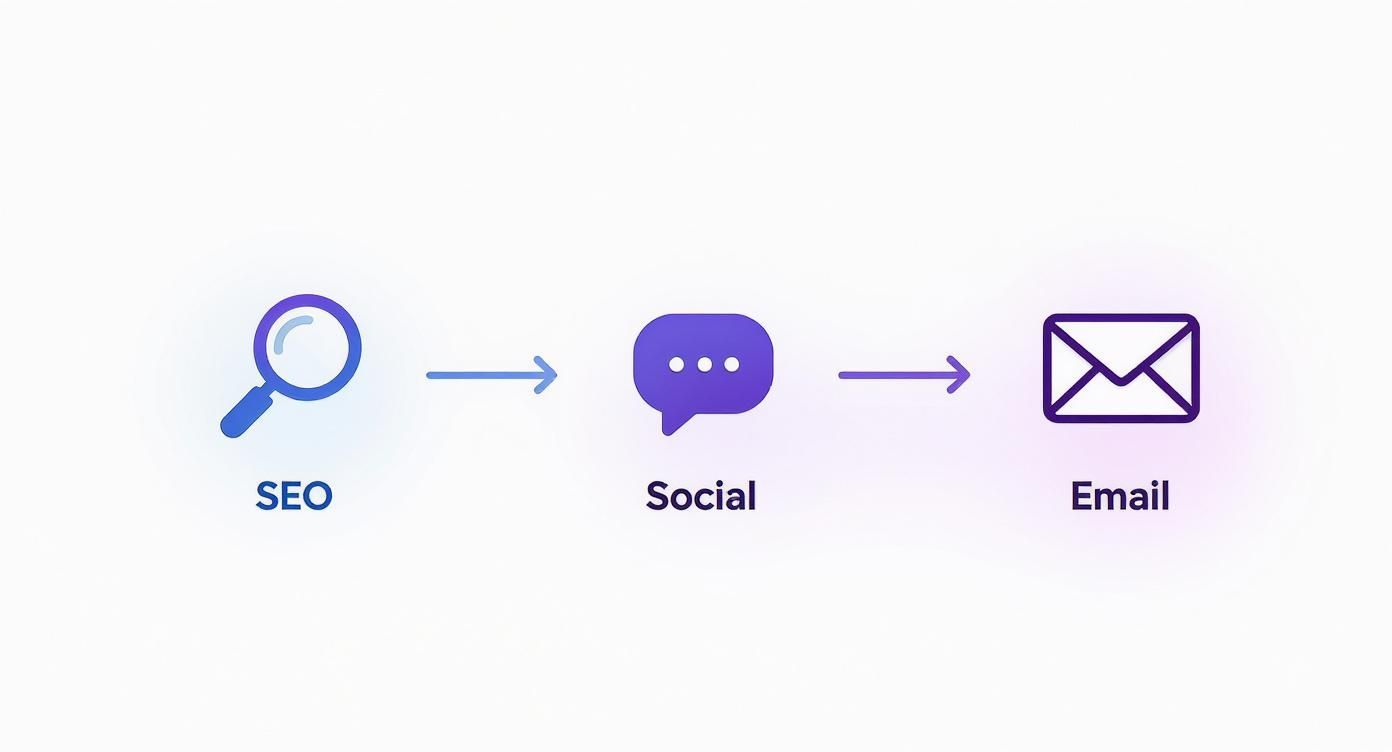
ai powered content creation: Boost Your Growth Now
Discover how ai powered content creation can transform your business with practical tools, strategies, and a clear growth roadmap.

So, what exactly is AI-powered content creation?
Think of it less as a robot taking over and more as a brilliant creative partner. It’s about using smart tools to help research, outline, and even draft content—from blog posts and emails to social media updates and product descriptions. This technology doesn't replace human creativity; it supercharges it.
At its heart, AI-powered content creation uses a technology called generative AI. These AI models have been trained on an incredible amount of existing text and images from across the internet, allowing them to learn patterns, styles, and structures.
When you give an AI tool a prompt—say, "write a blog post outline about the benefits of organic coffee"—it uses that training to generate something entirely new. It's not copying and pasting; it's predicting the next most logical word or phrase to build a coherent piece of content from scratch. This is what makes it a force multiplier for your marketing team.
Instead of spending hours on the tedious, repetitive parts of content production, your team can focus on what they do best: strategy, editing, and adding that unique brand voice that only a human can truly master. For a deeper dive, there are some great resources on using AI for content creation that build on these ideas.
Essentially, generative AI learns the underlying patterns of data it's shown. When you give it a command, it doesn't just pull from a database—it generates new, original output based on those learned patterns.
The image below gives you a simple visual of how a generative model takes in training data and then uses that knowledge to create brand-new content.

This ability to turn a simple instruction into a complex piece of writing or a stunning image is the engine behind all modern AI-powered content creation tools. It's what makes the magic happen.
So, we know what AI content creation is, but why should you actually care? For a growing business, it's less about the tech and more about what it can do for you right now. It boils down to one simple idea: doing more with what you’ve got.
The biggest win is scalability. Your small marketing team can suddenly punch way above its weight, churning out the volume of a much larger department. Imagine you need unique, SEO-friendly descriptions for 500 new products. With AI, that’s an afternoon's work, not a month-long headache.
That kind of scaling naturally leads to serious cost savings. Instead of bringing on more writers or freelancers to keep up, a single subscription to an AI tool can often handle the load for a fraction of the cost. It’s all about working smarter, not just harder.
But this isn't just about saving time and money. AI tools can actively improve your results. They're brilliant at personalization, helping you analyze customer data to craft email campaigns and social media posts that actually connect with specific groups of people.
When content feels like it was written just for them, engagement and conversions naturally follow. And the proof is in the numbers—around 70% of companies using AI for content creation have seen a major jump in how much content they can produce. You can see the full report on AI's impact on content workflows.
AI doesn’t just help you create more content; it helps you create smarter content. By automating the repetitive tasks, it frees your team to focus on high-level strategy and creative ideation, which is where true growth happens.
At the end of the day, bringing AI into your workflow is a strategic move to get more from your marketing. We dive deeper into this in our guide on how to use AI in marketing. It's about giving your team the power to execute bigger ideas without needing a bigger budget.
Okay, let's move past the theory. The real magic happens when you see how AI-powered content creation actually works for different parts of your marketing. It’s not just about speed; it's about getting smarter and more effective where it counts.
Here are a few ways businesses are already using it.
Think of AI as your new, super-efficient research assistant. For your blog, it can instantly analyze the top-ranking articles for any keyword you're targeting. From there, it can spit out a detailed outline and even write a solid first draft, complete with all the necessary subheadings and key points.
What used to take days of research and writing can now be condensed into a few hours of refining and adding your unique human touch.
On social media, you can use AI to generate a dozen different captions for one image. This lets you quickly test different hooks, calls-to-action, and hashtag combinations to find out what your audience truly responds to. It's like having a built-in A/B testing machine for your posts, helping you boost engagement without the guesswork.
Email marketing gets a major upgrade, too. AI can whip up attention-grabbing subject lines built to get more opens and even write personalized email copy tailored to different customer groups. The result? Better click-through rates and more sales.
For e-commerce, the impact is huge. Imagine you’re an online store adding 500 new products. Writing unique, SEO-friendly descriptions for each one would be a soul-crushing, weeks-long project.
With an AI tool, you can generate all 500 of those descriptions in a single afternoon. One retailer did exactly that and saw a 15% increase in organic traffic to their new product pages within the first month. Why? Because every single description was optimized for search engines right out of the gate.
And it’s not just about text. You can also create compelling presentations with AI for webinars, sales pitches, or internal reports, turning data and ideas into engaging visuals in a fraction of the time.
Jumping into AI-powered content creation doesn’t mean you have to tear down your current process. It's more about building a smart, structured system that gives your team superpowers. A solid workflow makes sure AI boosts your team's creativity, not replaces it.
The secret? Start with a clear plan. You wouldn't build a house without a blueprint, and the same principle applies here. First, figure out what you want to achieve. Are you trying to publish more blog posts, send hyper-personalized emails, or ramp up your social media presence? Our content marketing planning template is a great place to start mapping this out.
The best way to use AI in your content creation is with a "human-in-the-loop" approach. Think of it as having an incredibly fast assistant who handles the first draft, but your team always has the final say.
Here’s what that looks like in practice:
This tag-team approach gives you the best of both worlds: the speed of AI and the authenticity of human touch. The infographic below breaks down how this model works across different marketing channels.

This process shows just how easily AI-powered content creation can slide into your existing efforts to make everything more efficient. A huge reason for its adoption is AI’s knack for personalization. In fact, it's why the textual content segment of the AI market is projected to grab 45% of the market share by 2035. You can discover more insights about the AI content market and its rapid growth.
So, you're investing in AI-powered content creation—fantastic. But how do you actually prove it's working and not just a shiny new toy? Measuring its return on investment (ROI) goes way beyond just looking at the software subscription fee. You need to see the value it's adding across your entire process, from first draft to final sale.
The right metrics will help you build a rock-solid business case, showing stakeholders exactly how AI is impacting the bottom line. Let's break down how to track success in a way that tells the whole story.
To get a clear picture, you can’t just look at one number. You need to track a few different types of metrics that cover efficiency, performance, and quality.
Efficiency Gains: This is the most immediate win. How much faster are you creating content? Track the time saved per article—what used to take hours might now take minutes. You can also calculate the cost savings per asset. Just compare your AI tool's cost to what you would have paid a freelancer or agency for the same output.
Performance Metrics: This is where the rubber meets the road. Are more people finding you? Keep an eye on organic traffic and keyword rankings for your AI-assisted content. Even better, track conversion rates on AI-generated landing pages or product descriptions to tie your efforts directly to revenue.
Quality Indicators: Is the content resonating with your audience? Look at engagement metrics like time on page, bounce rate, and social shares. A lower bounce rate on a blog post you created with AI is a great sign that the content is hitting the mark.
Why is this so important? The global market for generative AI in content creation hit USD 14.8 billion in 2024. That's a lot of businesses jumping on board, and you can bet they're all trying to prove it was a smart move. You can read the full research about the generative AI market to see just how fast this space is growing.
For a more detailed breakdown of the financial side, our guide on how to calculate marketing ROI is a great place to start.

Jumping into AI-powered content creation can feel like a massive shortcut, but going in blind is a recipe for trouble. Think of it this way: you wouldn't hand over the keys to a high-performance car without learning how to drive it first. These tools are incredibly powerful, but they absolutely need a human in the driver's seat to keep your brand credible and your content trustworthy.
Let’s talk about the biggest pothole you might hit: factual accuracy. AI models are notorious for making things up with complete confidence. In the industry, we call these "hallucinations," where the AI generates plausible-sounding but completely false information. This is why a human fact-check is non-negotiable, especially for any content involving stats, data, or specific claims.
Then there's the issue of plagiarism. While AI tools are designed to create original text, they learn from a massive ocean of existing content. Occasionally, they can spit out sentences or phrases that are a little too close to their source material. A quick run through a good plagiarism checker is a simple safety net that can save you a lot of headaches.
One of the sneakiest risks is watching your brand’s personality get watered down into something generic. An AI doesn't know your company's backstory, your quirky sense of humor, or the specific way you talk to your customers. Left on its own, it will churn out bland, soulless content that just doesn't connect.
The best approach is to treat your AI tool like a new hire who needs onboarding. Give it a detailed brand style guide with crystal-clear rules on tone of voice, preferred words, and things to never say. This builds the guardrails it needs to start sounding less like a robot and more like you.
By putting these simple checks and balances in place, you’re not just avoiding risk. You’re turning a powerful technology into a reliable partner that helps you scale your content creation the right way.
This is the big question, isn't it? But the short answer is no. It’s better to think of AI-powered content creation as a co-pilot, not an autopilot.
AI is fantastic at the heavy lifting—the initial research, the first drafts, the repetitive tasks that eat up so much time. This actually frees up your human writers and strategists to focus on what they do best: high-level strategy, deep creativity, and infusing your unique brand voice into every piece. It’s a partnership, with a human always in the driver’s seat.
Originality is everything, and this is where your team's role is critical. You should treat anything an AI produces as a first draft, a starting point. Never just copy and paste.
Your team needs to step in to edit, fact-check, and most importantly, add their own human experiences, stories, and insights. That’s how you take a generic AI output and turn it into something that’s truly yours and speaks directly to your audience. That human layer is what makes content authentic.
Surprisingly, yes—if you teach it properly. Modern AI tools are incredible learners. You can train them on your existing content, like your best-performing blog posts or emails, and feed them a detailed style guide.
By giving the AI clear examples and specific rules—what words to use, what to avoid, the personality you want to project—you can get it to generate content that sounds remarkably like you. It takes some initial effort, but the payoff is content that feels consistent and on-brand.